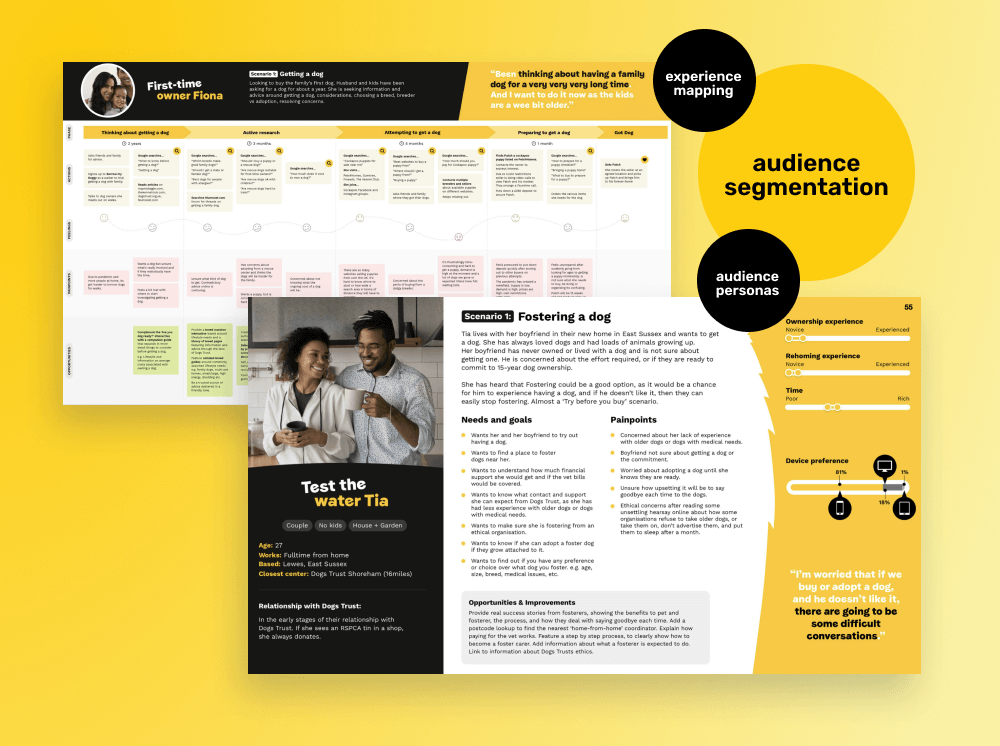Leading the user-centred discovery of Dogs Trust digital transformation
As the UX lead at Aer Studios, I played a pivotal role in securing and leading a two-year digital transformation project for Dogs Trust. Our primary objective during the Alpha phase was to craft an unparalleled user experience that seamlessly supported Dogs Trust's mission while delivering a best-in-class product. This endeavor necessitated a deep dive into understanding Dogs Trust's diverse audiences, their interactions, and their expectations across all touchpoints.
The project presented multifaceted challenges, including the need to comprehensively understand Dogs Trust's audience dynamics, overhaul the existing information architecture, and develop meaningful audience personas. Additionally, we faced the task of integrating new features while ensuring alignment with Dogs Trust's overarching goals and values.
To tackle these challenges, we embarked on a journey of thorough user research, data analysis, and usability testing. Utilising techniques such as Card Sorting and Tree Testing, we iteratively refined the information architecture to enhance user navigation and streamline content discovery. Audience segmentation and persona creation provided invaluable insights into user motivations, behaviours, and preferences, guiding our design decisions and feature prioritisation.
Furthermore, we employed experience mapping to help visualise these diverse user journeys, uncover pain points, and identify opportunities for improvement. Subsequent UI design iterations, particularly focusing on critical user journeys like adoption, underwent rigorous usability testing to ensure intuitive navigation and effective content delivery. Through a collaborative and user-centric approach, we successfully transformed Dogs Trust's digital ecosystem, delivering a solution that not only met but exceeded user expectations, ultimately supporting Dogs Trust's noble cause with unparalleled digital experiences.
Testing the IA - I conducted rigorous testing on the Information Architecture (IA) using a strategic approach that involved both Card Sorting and Tree Testing methodologies. Initially, I employed Card Sorting to understand how users naturally grouped content types, utilising a diverse mix of participant recruitment methods including social media and organic traffic. This provided valuable insights into users' terminology and language patterns, which informed subsequent Tree Testing.
In the Tree Testing phase, I implemented two variations of the reformed IA and presented participants with tasks to locate specific content within the navigation tree. This approach allowed for direct comparison between the two navigational models, yielding insightful analytics on their effectiveness and success rates. These findings were instrumental in building confidence and advocating for the final IA proposal.
Audience Segmentation - Drawing from a wealth of data sources including IA tests, stakeholder reviews, analytics, focus groups, and usability sessions, I facilitated the development of comprehensive audience personas for Dogs Trust. These personas provided invaluable insights into not only the demographics of Dogs Trust users but also their motivations, behaviours, and timing of interactions. By delving into the 'why', 'how', and 'when' aspects of user engagement, we identified key needs, content opportunities, pain points, device preferences, and various personality traits, all of which would be used to drive our design discussions and creative direction.
In addition to persona creation, we crafted experience maps that depicted a holistic user journey with Dogs Trust. These maps outlined the journey from initial thought processes and research to the emotional highs and lows experienced throughout the interaction with all touch points of Dogs Trust. By incorporating data and observations gathered during testing, these maps enriched stakeholder understanding and fostered empathy towards Dogs Trust audiences, ultimately enhancing the project's overall richness and effectiveness.
User Testing - After synthesising the research findings, the UI team embarked on developing the initial UI, prioritising the 'adoption' journey. Once the screens were designed and a prototype was prepared, I facilitated a series of usability testing sessions. These sessions included a diverse mix of recruited participants and known supporters of Dog's Trust.
The primary focus of these sessions was to assess the prototype's usability, particularly its ability to guide users through the adoption journey. We evaluated the 'findability' of content within the new IA and navigation models, assessed the effectiveness of the content, and identified areas of the prototype that were intuitive as well as those needing improvement. Through these rigorous testing sessions, we gained valuable insights that informed iterative improvements to the prototype and UI design, ensuring a seamless and user-friendly experience for Dogs Trust visitors.
This project marked a pivotal moment in my career, where my primary role and utmost priority were to serve as the lead researcher, advocating for the user's perspective throughout the project lifecycle. Tasked with being the voice of the user, I played a central role in synthesising research insights and effectively communicating them to stakeholders and the delivery team.
Through this extensive discovery phase, we successfully transformed abstract concepts into tangible solutions that resonated with Dogs Trust's diverse audiences. We created a strong set of UX principles and established a scalable, consistent design system and set of UI patterns that would underpin the continued design of the new website into future phases of this project.
- User research through stakeholder reviews and user interviews
- IA testing through card sorting and tree testing
- Usability testing
- Persona creation and experience mapping



